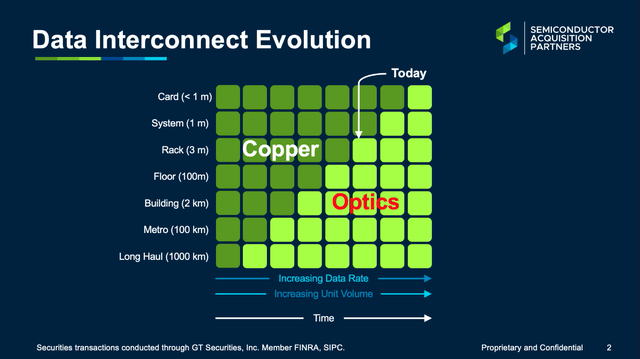We keep hearing about building future-ready 5G and FTTH networks around the world. At the heart of these networks are connections as lengthy as data center to data center, and as minuscule as chip to chip.
But what exactly makes these connections and networks future-proof? The idea is that they should be able to support growing interconnect fiber optic cable speeds to the tune of 100 GB/s and beyond. The greater the speed, the greater the capacity to meet the insatiable data appetite of emergent technologies like AI, ML, IoT, cloud computing, video streaming, and hyper-convergence.
One of the most promising technologies in this field is optical interconnect. Unlike traditional copper-based interconnects, optical interconnects use light to transmit data through optical fibers, providing faster speeds and longer distances. Integrated optical interconnects aim to meet the demand for low-cost, power-efficient, high-bandwidth interconnects, particularly in data centers for server communication.
Needless to say, as a successor technology, the benefits of optical interconnect are numerous. In this blog, we will explore the key benefits of optical interconnect technology and why it is becoming increasingly important in modern communication systems.

Image Credit : seekingalpha.com – Evolution of data interconnect
Contents
Optical interconnect: A closer look
What does a typical optical interconnect comprise of?
Think of a bundle of optical fiber cables that connect to transceivers between different hardware. These transceivers comprise a package of lasers and detectors that are equipped to both receive and transmit optical signals. The specifications of these transceivers are also ever-changing, depending upon a multitude of requirements: form factor, specifications, speeds, protocols, etc.
But that is not all. Optical interconnect also consists of multiple categories of devices for specific applications. These include everything from fiber termination boxes and joint closures to patch cords and an entire suite of fiber management systems. These optical interconnect products are typically designed as modular, customizable solutions that can be plugged into existing fiber networks to augment their performance.

Image Credit : wwt.com – Optical interconnect architecture connecting two data centers
As such, optical interconnects link the hardware across varying degrees of distances. They can bridge long-distance data networks or, more commonly, connect data centers. Optical interconnects also find usage in wired and wireless access networks. Ultimately, the main benefits of optical interconnect that have made them so popular are low latency, increased power efficiency, and higher throughput.
Advantages of optical interconnect
1. Faster speed, more bandwidth
More and more organisations are shifting to the cloud and web traffic is ready to explode to the tune of 79.4 zettabytes by 2025 solely from connected devices. That places a greater emphasis on upgrading the capacity, speed and availability of data centers. One of the most obvious benefits of optical interconnect technology is the higher bandwidth and faster data transmission speeds it enables.
Because light travels much faster than electricity, optical interconnects can transmit data at much higher speeds than traditional copper-based interconnects. In fact, modern optical interconnects can transmit data at speeds up to 100 Gbps, which is 10 times faster than traditional copper-based interconnects. With the evolution of benefits of optical interconnect, this speed can be pushed further to the 800G category and beyond.
2. Distance
Distance is another important factor when it comes to communication systems. Traditional copper-based interconnects are limited in the distance they can transmit data. Consequently, as the bandwidth requirement increases, the signal deteriorates over longer distances.
However, optical interconnects are able to transmit data over much longer distances without any loss in signal quality. This is because optical fibers are made of glass or plastic, which do not conduct electricity and are immune to electromagnetic interference (EMI) and radio frequency interference (RFI). This means that optical interconnects can transmit data over distances of several miles without the need for signal amplifiers or repeaters.
3. Reliability and durability
Another key benefit of optical interconnect technology is its reliability and durability. Optical fibers are made of glass or plastic, which are much more durable than traditional copper-based wires. They are also immune to EMI and RFI, which means that they are less likely to be affected by external factors such as weather or power surges. This makes optical interconnects ideal for harsh environments where traditional copper-based interconnects would not be able to function reliably.
4. Cost-effectiveness and energy efficiency
While optical interconnects may have a higher initial cost than traditional copper-based interconnects, they can be more cost-effective in the long term. This is because optical interconnects have a much longer lifespan than traditional copper-based interconnects.
They also have lower maintenance costs and power consumption. This is because an optical signal can travel longer distances without the need for amplification, which can be achieved by low transmission power. This yields significant savings over time. In fact, a study has proven that all-optical networks in data centers can result in up to 75% energy savings.
5. Modularity and upgradability
The disaggregation of modern data centers is another critical paradigm unfolding in front of our eyes. It has also been made possible due to the impetus provided by the seamless integration of optical interconnect technologies. Thanks to their modularity and ‘plug-and-play’ features, optical interconnect bundles can be flexibly plugged into the existing data network infrastructure without any compatibility issues. This paves the way for supporting 400G, 800G, and 1.6T Ethernet.
6. Reduced network overhead
Managing the burgeoning energy and power consumption requirements of data infrastructure means reducing the network overhead. This is where the smaller form factor and reduced weight of optical fiber interconnect comes in handy. By implementing optical interconnect, we can reduce heat dissipation and network wiring. Additionally, optical interconnect also facilitates the utilisation of flat architecture design, further reducing the network overhead.
Wrapping up: Where the future of optical interconnect lies
Optical interconnect technology is constantly evolving, and new developments are being made all the time. Not surprisingly, by 2025, the global optical interconnect market is projected to reach USD 17.1 billion by 2025 at a CAGR of 13.7%.
One area of particular interest is the potential for increased bandwidth. With the growth of internet usage and the increasing demand for data-intensive applications, the need for more bandwidth is greater than ever. This will be further exacerbated by the growing machine-to-machine traffic in the age of IoT.
Another area of future advantages of optical interconnect is the potential for new applications. For example, optical interconnect can be used in medical instruments to transmit high-resolution images, or in autonomous vehicles to transmit large amounts of data in real time. Already, optical interconnect technology is revamping shorter-reach communication at the chip and processor level via integrated photonics.
These are just a few examples of the many possibilities that optical interconnects offer. With companies like STL driving innovation in this field, we can expect to see even more developments in the future. Our broad portfolio of modular, plug-and-play, customizable, and highly compatible optical interconnect products is ready-made for scaling up fiber deployments in the US. Attuned to the specific needs of networks and service providers, STL’s optical interconnect suite across the exchange, OSP and distribution access makes the creation of fiber deep networks more flexible and agile than ever.
Learn more: https://www.stl.tech/optical-interconnect-products/optical-interconnect-kits/















